Evaluation of Polar-Embedded and Polar-Endcapped C12-C18 Stationary Phase Vulnerabilities Toward Highly Nucleophilic Compounds: A Case Study
LCGC North America
Here the authors discuss an ion-pair, gradient HPLC method, developed for cycloserine-related substances using a polar, amide-embedded C18 column. Other polar-embedded and polar-edcapped columns are evaluated in equivalence studies.
In developing the method, it was found that one of the related substances, cycloserine dimer, exhibits a suppressed UV response (column discrimination) with many of the columns. This can be overcome through a series of conditioning injections with concentrated dimer standard solution. Once these columns reached a conditioned state, the UV response remained consistent through repeated column cleanup with 50:50 acetonitrile–water and 100% acetonitrile, storage in 100% acetonitrile, and reuse. This discrimination towards the dimer appears to be related to column silanols in spite of the theoretical masking of those silanols by the polar-embedded groups. D-Cycloserine is an antibiotic used to treat multidrug resistant tuberculosis. Cycloserine's primary degradation product, in both solid state and solution, is cycloserine dimer (1–4). Figure 1 shows structures of both cycloserine and its dimer.
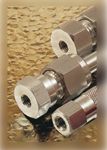
Ion-pair HPLC methods using either postcolumn derivitization with fluorescence detection or simple low UV detection have been applied to analysis of cycloserine (5,6). Our focus was to develop a related substance method to support both the manufacturing of bulk drug starting with D-serine and analysis of final capsule formulations. Short polar-embedded phase HPLC columns were included in development studies based upon their advantages for analysis of small, polar compounds using highly aqueous mobile phases (7,8). Additionally, the short columns with 3–4 μm particles were sought for fast analysis of the related substances.
A fast, gradient HPLC assay from 0 to 30% acetonitrile with aqueous component of 20 mM octanesulfonic acid (pH 2.5), sodium salt solution provided the best separation and fastest analysis of all process intermediates, cycloserine, its dimer, and other impurities. Application of the postcolumn o-phalthaldehyde derivatization and fluorescent detection used by Musson and colleagues gave good sensitivity for process intermediates, but the dimer does not react with o-phalthaldehyde to provide a fluorescent product (which is one problem with the dimer analysis) (5). UV detection at 210 nm was adopted for monitoring the dimer, its degradation products, and other cycloserine impurities in final cycloserine capsule formulations.
Examination of new lots of Prontosil C18 EPS columns (Mac-Mod Analytical, Chads Ford, Pennsylvania) revealed that UV response of the dimer was much less than the response on older (high injection volume) columns, but other impurities and cycloserine parent peak gave comparable responses across all test columns. Conditioning these new columns with injections of high-concentration dimer standard eventually provided a repeatable, stable, and comparable response to older columns and provided a consistent relative response to cycloserine and other impurities. We speculated that the dimer might be reacting with the embedded amide via hydrogen bonding or other adsorption mechanisms. Multiple vendors' amide and sulfonamide phases were evaluated to see if the phenomena persisted across all amide-like phases. The dimer's biased response was not consistent across all of the columns.
Something aside from the embedded amide appeared to be the source of our problem. We now speculated that perhaps the column silanols might be a factor. Other columns targeted for small, polar compounds that include polar-embedded or polar-endcapped phases were included in column equivalence studies to see if the "dimer discrimination" occurred on those phases. From comparisons of identical phases with and without endcapping, it appears that the residual silanols might be the root cause of this discrimination in UV response of the dimer.
Hydroxyurea, another nucleophilic compound, was examined in these column studies to determine whether other compounds with the oxyamine structure would exhibit UV discrimination like the dimer (Figure 1). A similar effect was seen.

Figure 1: Structures of cycloserine, cycloserine dimer, and hydroxyurea.
Experimental
Instrumentation: Waters Alliance 2695 Separations Module (Milford, Massachusetts) with a Waters 2487 UV detector was used throughout these experiments. The detector was set at 210 nm UV. Data were collected using Waters Millenium software. Samples were held on the autosampler at 5 °C, while the column was held at ambient temperature. The gradient program is listed in Table I.
Chemicals: HPLC grade 1-octanesulfonic acid, sodium salt was purchased from both Fluka and Sigma (both c/o Sigma-Aldrich, St. Louis, Missouri). HPLC grade acetonitrile was purchased from J.T. Baker (c/o Mays Chemical Co., Indianapolis, Indiana); and 85% HPLC grade phosphoric acid was purchased from Fisher Scientific (Fisher, Fairlawn, New Jersey). Purified HPLC grade water (Millipore, Billerica, Massachusetts, or equivalent) was used in mobile phase preparation and as sample solvent. Reference standards of cycloserine and cycloserine dimer were obtained from Lilly Reference Standards Lab (Eli Lilly and Co., Indianapolis, Indiana). Hydroxyurea also was obtained from Sigma-Aldrich.

Table I: HPLC pump gradient program. Note: flow set at 2.0 for columns longer than 75mm.
HPLC columns: All of the tested columns were 75 mm × 4.6 mm or longer with particle sizes specified in Table II. Flow rate was set at 1.5 mL/min for 75-mm length columns and set at 2.0 mL/min for longer columns.
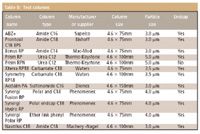
Table II: Test columns
HPLC conditions: Mobile phase A was 20 mM octanesulfonic acid adjusted to pH 2.5 with phosphoric acid and mobile phase B was 100% acetonitrile. Samples were prepared in water and held at 5 °C at the following test concentrations: cycloserine at 0.1–0.2 mg/mL, cycloserine dimer at 0.4–0.5 mg/mL. 10-μL sample injections were made at 20 min gradient cycle intervals allowing sufficient column equilibration between cycles. Note that these analyses use a fast gradient profile, which is sufficient for the study at hand. However, during routine application of our test method, gradient slope is reduced (15 min added to last two lines of Table I program) to improve a critical pair dimer-impurity resolution. The fast gradient is good for column conditioning and equivalence scouting studies.
Results and Discussion
Column equivalence studies — amide phases: Initially, multiple lots of the Prontosil C18 EPS were the focus of our dimer equilibration (discrimination) studies. New columns required 16–20 injections of the dimer standard solution until stable UV response was achieved, producing a consistent relative response of the dimer to both cycloserine and other impurities compared to older Prontosil columns. Only the dimer showed this progressive increase in UV response with conditioning. The net change in UV response was about 1.5x that of the initial dimer standard injection on these new columns. All other impurity peaks and cycloserine were stable throughout the conditioning injections.
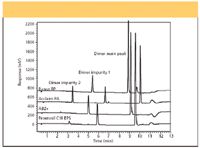
Figure 2: Selectivity comparison of ABZ+, Bonus RP, and Acclaim PA to Prontosil C18 EPS using various aged dimer standard solutions. Dimer produces impurity 2 as it ages in solution.
To determine whether this discrimination phenomenon was a function of these columns only, other vendors' amide-embedded phases (or sulfonamide embedded) were evaluated. Mac-Mod Bonus RP and Supelco ABZ+ (Bellefonte, Pennsylvania) contain an amide-embedded phase while Dionex Acclaim (Sunnyvale, California) is a sulfonamide-embedded phase. Selectivity of these columns toward the dimer, cycloserine, and the impurities were comparable, as seen in Figure 2. The characteristic fingerprint of cycloserine to the dimer and its impurity 1 was fairly consistent across all the columns, with cycloserine eluted about 1 min before dimer impurity 1, as seen in Figure 3.
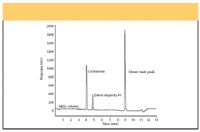
Figure 3: Elution profile of cycloserine to dimer and its primary impurity 1 on a Supelco ABZ+ column.
Dimer discrimination occurred on all amide-embedded columns except for the Bonus RP. Multiple lots of the Supelco ABZ+ and Bonus RP were evaluated. The previously mentioned sulfonamide column had a dimer response increase about 1.6x, while the ABZ+ lots varied from about 1.1x to 2.0x the initial dimer standard injection UV response. The ABZ+ lot-to-lot variability suggests there might be differences in the column manufacturing that contribute to the discrimination we observed with the dimer standard. Each lot of Bonus RP showed stable dimer to cycloserine ratios across 18 injections of standard mixture.
Analysis challenges include the following:
- One of the key advantages of polar-embedded phases is that they are supposed to shield interactions of analytes with surface silanols (8–11).
- There might be problems in column manufacturing that produce inconsistencies and incomplete reactions in stationary phase bonding chemistry (12).
- Ion-pair chromatography used in this assay should help mask silanols at the column surface by the very nature of the coating of the ion-pair reagent (13).
- Lassen and colleagues described this dimer, and oxyamines in general, as being very nucleophilic, which might account for the column discrimination observed (2).
Column equivalence studies — other phases: Embedded phases of carbamate and urea, polar-endcapped C18, and a mixed-phase C18 embedded phase (Synergi Fusion, Phenomenex) showed similar selectivity toward test compounds. Both Waters carbamate-embedded phases showed baseline shift during the gradient similar to "phenyl bleed" seen using phenyl phases. The Synergi Polar RP showed extreme "phenyl bleed," making it unacceptable for use. Carbamate, Hydrobond, and Fusion columns did not show discrimination toward dimer.
Urea phase columns, Prism RP, and Prism RPN, both exhibited discrimination. Equilibration injections using the Prism RP produced a 1.4x change in dimer UV response after about nine injections of the dimer standard. The Prism RPN, a nonendcapped equivalent of the RP, showed extreme bias towards the dimer with a 33x increase in dimer UV response after about 18 standard injections. There was no apparent effect on peak shape, only a progressive increase in UV response as equilibration injections progressed, as seen in Figure 4. One might expect impact on peak shape if silanol interactions were occurring, but peak shape is normal and consistent. The only difference in the two columns is endcapping suggesting that, in fact, the silanols are the contributing factor to the observed discrimination behavior toward the dimer.

Figure 4: Increasing dimer main peak response on nonendcapped Prism RPN.
Similar compound discrimination: Hydroxyurea was prepared in purified water and profiled on a new ABZ+ column using only 100% mobile phase A. This compound is eluted near the void volume of the column, but observation of change in UV response over the course of equilibration injections still showed about 1.1x increase after about 10 sample injections. This conditioning was followed by routine gradient profiles of hydroxyurea standard (20 repeat injections) followed by mixed standard of cycloserine and dimer injections (15 repeat injections). The hydroxyurea increased about 15% from above conditioning injections (see Figure 5), while the dimer response in the mixed standard increased about 1.4x the initial standard injection UV response. These conditions for which the hydroxyurea were run under were not ideal conditions for hydroxyurea, but are ideal for cycloserine and dimer. Reproducibility is not an issue for the cycloserine or the dimer.
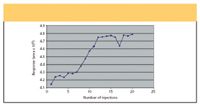
Figure 5: Increasing dimer main peak response on nonendcapped Prism RPN.
Effect of concentration to speed equilibration: Three columns from the same lot of Prontosil C18 EPS were evaluated using three concentrations of dimer standard solution to assess speed of equilibration. At 0.5-, 1.0-, and 2.0-mg/mL test standard concentrations used, all of the columns equilibrated very quickly (within one or two injections). This was the best set of columns obtained to date and was not consistent with the 6–8 previously tested columns in terms of time required to achieve stable UV response. This does, again, point to variability seen lot-to-lot with the embedded phase columns.
Conclusions
The discrimination behavior observed with these polar-embedded and polar-endcapped phases varied. The most striking effect was with nonendcapped and endcapped urea phase, which suggests that silanols might be at the heart of our observed behavior. Another nucleophilic compound exhibited similar behavior on columns proven to exhibit bias towards the dimer. Though polar-embedded groups are supposed to mask silanol activity, highly nucleophilic compounds need to be evaluated closely to assess whether discrimination occurs versus other test compounds. In conclusion, a column can be defined as encapped, but the degree of endcapping is what should be looked at with great scrutiny before using a column for quantitative purposes.
Acknowledgments
The authors wish to thank Bob Bridge, Dionex, and Craig Levinson, Waters, for providing HPLC columns to include in this evaluation. They would also like to thank Bob Moody and Carl Zimmerman of Mac-Mod for technical consultation throughout this investigational study, and Ken Bowers, Eli Lilly Tippecanoe Labs, who laid the groundwork for this related substances method and collaborated throughout development and validation studies. Finally, they would like to thank Don Risley, who provided technical guidance and aid with manuscript preparation.
Larry J. Burge is assistant senior analytical chemist and Christina M. Sorgen is associate analytical chemist with Eli Lilly and Company, Indianapolis, Indiana.
References
(1) T. Tukamoto and S. Ozeki, Yakuzazaigaku 27(4), 336–339 (1967).
(2) F.O. Lassen and C.H. Hammer, J. Org. Chem. 56(18), 2631–2634 (1971).
(3) J.W. Lamb, Anal. Profiles Drug Subst. 1, 53–64 (1972).
(4) H.L. El-Obeid and A.A. Al-Badr, Anal. Profiles Drug Subst. 18, 567-597 (1989).
(5) D.G. Musson, S.M. Maglietto, S.S. Hwang, D. Gravellese, and W.F. Bayne, J. Chrom. 414, 121–129 (1987).
(6) United States Pharmacopeia 25, National Formulary 20, (United States Pharmacopeial Convention, Inc., Rockville, Maryland, 2001).
(7) Mac-Mod Technical Report, Number 00111TR.
(8) Mac-Mod HPLC Columns Product Bulletin, Number 000401PB.
(9) Mac-Mod HPLC Lab Notes, "When to Use a Polar Embedded Phase Column," Sept. 4, 2001.
(10) P. Ross, I.D. DeGraff, and R.A. Henry, "A Comparative Study of HPLC Stationary Phases with Unique Polar Selectivity," Thermo Hypersil-Keystone Scientific Operations technical publication (Thermo Electron, Waltham, Massachusetts).
(11) J. Layne, J. Chrom. 957(2), 149–164 (2002).
(12) U.D. Neue, Am. Lab. 33(18), 49–50 (2001).
(13) L.R. Snyder, J.J. Kirkland, and J.L. Glajch, in Practical HPLC Method Development, 2nd ed. (John Wiley & Sons, Hoboken, New Jersey, 1997), pp. 317–321.

Common Challenges in Nitrosamine Analysis: An LCGC International Peer Exchange
April 15th 2025A recent roundtable discussion featuring Aloka Srinivasan of Raaha, Mayank Bhanti of the United States Pharmacopeia (USP), and Amber Burch of Purisys discussed the challenges surrounding nitrosamine analysis in pharmaceuticals.
Extracting Estrogenic Hormones Using Rotating Disk and Modified Clays
April 14th 2025University of Caldas and University of Chile researchers extracted estrogenic hormones from wastewater samples using rotating disk sorption extraction. After extraction, the concentrated analytes were measured using liquid chromatography coupled with photodiode array detection (HPLC-PDA).











